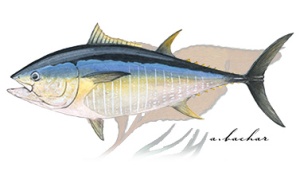
Historically, Pacific bluefin tuna show up in California and Baja California waters each year during the late summer months. Last year, however, these sought-after tuna arrived in good numbers and never left, with 2016 catches occurring in pulses since February. The California Department of Fish and Wildlife (CDFW) reminds anglers that new recreational regulations for Pacific bluefin and other tunas, adopted last year by the California Fish and Game Commission, are now in effect and available for review in the current California Ocean Sport Fishing Regulation booklet.
California’s recreational tuna regulations – California Code of Regulations (CCR) Title 14, sections 27.65 and 28.38 – were changed to conform to federal regulations that reduce the catch in accordance with international treaty agreements that address overfishing across the north Pacific. In response to the Inter-American Tropical Tuna Commission (IATTC) recommendation to reduce Pacific bluefin tuna recreational and commercial landings, the Pacific Fishery Management Council (PFMC) examined a suite of reduction options for West Coast daily recreational bag limits. The PFMC ultimately recommended that NOAA Fisheries reduce the limit from 10 fish to two fish per person. The bag reduction, which was adopted into federal and state law, is expected to reduce the U.S. recreational catch of Pacific bluefin tuna by an estimated 30 percent. The new bag limit affects anglers fishing in U.S. waters, as well as anglers that fish in Mexican waters and land their catch in California.
Current Recreational Regulations
The new tuna regulations went into effect on August 13, 2015. Currently, two Pacific bluefin tuna may be taken or possessed in addition to the general daily bag limit of 20 finfish specified in CCR Title 14, Section 27.60(a). This limit applies to all Pacific bluefin tuna possessed, regardless of where they are taken.

For a multi-day trip – one that extends for a period of 12 hours or more on the first and last days of the trip – a Declaration for Multi-Day Fishing Trip is needed. The bag limit for multi-day trips with a properly filed Declaration issued by CDFW is as follows:
- For trips two days in length, the possession limit is four (4) Pacific bluefin tuna
- For trips three days or longer, the possession limit is six (6) Pacific bluefin tuna
No berthing or docking is permitted within five miles of the mainland shore during the trip. This is applicable to both private vessels and commercial passenger fishing vessels. The form “must be submitted to the nearest department office in order for any person aboard such boat to possess more than one bag limit of saltwater fin fish, abalone, lobster and rock scallops.” If mailed, it must be received at least 48 hours prior to departure. The fee for filing a Declaration for Multi-Day Fishing Trip is currently $5.92.
Fillet rules for tuna also changed to allow for species identification by law enforcement officers and biologists. The new rules were created with input from state and federal regulatory agency scientists, law enforcement, and the fishing industry, and adopted into federal and state law. All filleted tuna landed south of Point Conception must be cut into six pieces with the skin attached, as described below:
- The four loins (two upper and two lower)
- The belly fillet including the pelvic fins and urogenital vent
- The collar with pectoral fins attached
 Each fish must be placed in its own bag and labeled with the species’ common name. Tunas may also be kept whole, or dressed in a manner that retains these identifying characteristics.
Each fish must be placed in its own bag and labeled with the species’ common name. Tunas may also be kept whole, or dressed in a manner that retains these identifying characteristics.
Commercial Regulations
The IATTC conservation and management measures adopted in 2014 to address overfishing of Pacific bluefin tuna apply to the commercial sector as well. The IATTC fishery management recommendations in IATTC Resolution C-14-06 call for the reduction of the commercial Pacific bluefin tuna catch by 20 to 45 percent of the 2002 to 2004, Pacific-wide average catch for treaty member nations.
The U.S. West Coast allocation for the commercial catch was reduced from 500 metric tons (mt) in 2014 to a two-year catch limit of 600 mt for 2015 and 2016 combined, not to exceed 425 mt in a single year. This represents an approximately 40 percent reduction in the catch allowance in accordance with the IATTC resolution. NOAA Fisheries also implemented a commercial trip limit of 25 mt until cumulative commercial landings are within 50 mt of the catch limit. Once within 50 mt of the limit, trip limits drop to 2 mt. These trip limits were implemented to ensure catch levels do not exceed the catch limit set by the IATTC.
CDFW monitors Pacific bluefin tuna commercial and recreational landings in California, and is working closely with NOAA Fisheries and constituents to enhance and improve biological data collection to inform future stock assessment work and to expedite catch tracking and reporting.
For more information about Pacific bluefin tuna management and regulations, visit the following websites:
wildlife.ca.gov/Conservation/Marine/Pelagic
post by Trung Nguyen, CDFW Environmental Scientist

